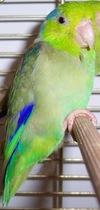Genus Forpus

Pacific Parrotlet - Parrotlets are the second smallest group of all parrots. Pacific Parrotlets are between 4 1/2 to 5 1/2 inches in length. They come from the South American countries of Peru and Ecuador. There are seven species of Parrotlets. Only three of these species are kept as pets. Of these, the Pacific Parrotlet is the most common.
Spectacled Parrotlet - The Spectacled Parrotlet is a species of parrot in the Psittacidae family. It is found in Colombia, Panama, and Venezuela. Its natural habitats are subtropical or tropical dry forests, subtropical or tropical moist lowland forests, and heavily degraded former forest.
Mexican Parrotlet - Its natural habitats are subtropical or tropical dry forests and heavily degraded former forest.
Dusky-billed Parrotlet - The Dusky-billed Parrotlet , also known as the Sclater's Parrotlet, is a small species of parrot in the Psittacidae family. It is found in the Amazon Rainforest in South America, where it is locally fairly common; it is in the Andes, and the Amazonian foothills; also the Amazon River outlet, and Marajo Island. It resembles other parrotlets, but has a largely dark upper mandible.
Green-rumped Parrotlet - Its habitat is open forest and scrub. The female lays five to seven white eggs in a hole in a termite nest, tree cavity, or even hollow pipe, and incubates the clutch for 18 days to hatching, with about another five weeks to fledging.
Yellow-faced Parrotlet - It is treatened by habitat loss and trapping for the wild bird trade. The latter caused a rapid decline in the 1980s, but following a ban, the numbers appear to have stabilised, although at a very low number, with less than 1000 individuals remaining in the wild.
Blue-winged Parrotlet - The Blue-winged Parrotlet is a small parrot found in much of South America. It includes the Turquoise-rumped Parrotlet , which sometimes is treated as a separate species. The Blue-winged Parrotlet is mainly found in lowlands, but locally up to 1200m in south-eastern Brazil. It occurs in woodland, scrub, savanna, and pastures. Flocks are usually around 20 birds but can grow to over 50 around fruiting trees or seeding grasses. It is generally common and widespread, though more localized in the Amazon Basin.



